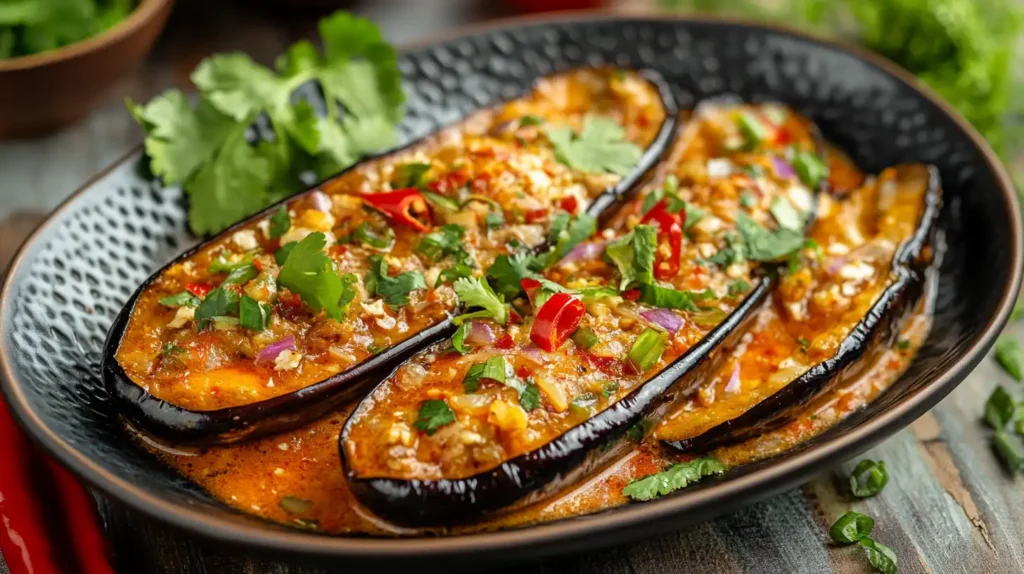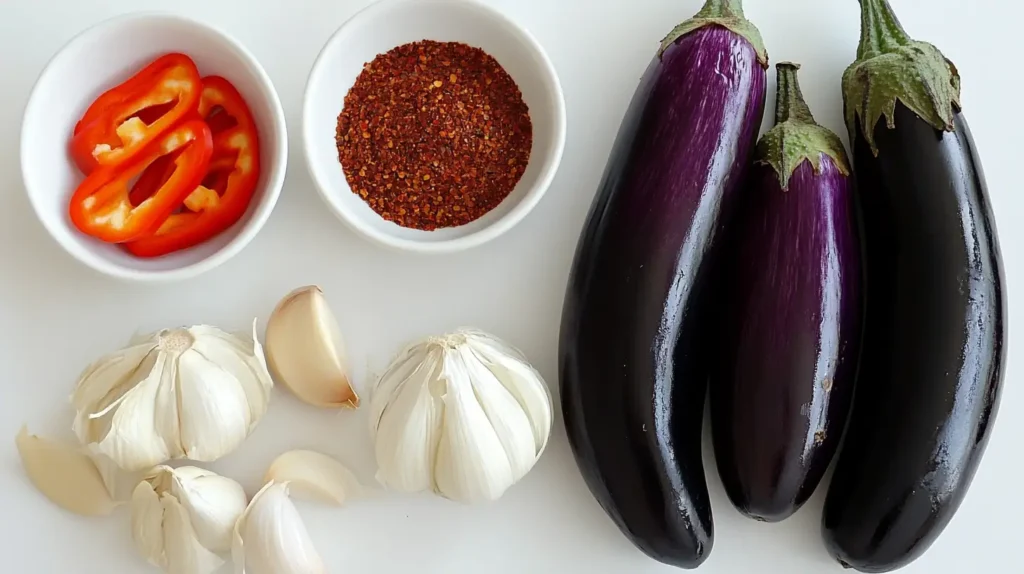Introduction to Thai Aubergine Recipe

What Are Thai Aubergine Recipe?
Thai aubergine Recipe, also known as Thai eggplants, are small, round vegetables typically green with cream-colored streaks. They are much smaller than traditional purple eggplants, resembling the size of a golf ball. Known for their mildly bitter and earthy flavor, Thai aubergines offer a unique texture—crunchy when raw and tender when cooked. These versatile vegetables are staples in Thai cuisine, often featured in curries, stir-fries, and salads.
Their ability to absorb flavors makes them an excellent choice for dishes with bold spices like red curry paste and creamy coconut milk. If you’re exploring the use of vibrant vegetables in global recipes, consider this Crawfish Fettuccine Recipe for its emphasis on bold ingredients.
History and Origin of Thai Aubergine Recipe
The origin of Thai aubergines is rooted in Southeast Asia, where they have been cultivated for centuries. They belong to the nightshade family (Solanaceae), alongside tomatoes and peppers. Native to Thailand and neighboring countries, Thai aubergines have become a fundamental ingredient in traditional Thai cooking. Historically, they were grown for their resilience to tropical climates and their role in enriching local diets.
These aubergines also hold cultural significance, often used in rural Thai kitchens as a versatile and affordable vegetable. Their introduction to global markets has made them increasingly popular in Asian grocery stores and specialty markets.
Culinary Significance in Thai Cuisine
In Thai cuisine, Thai aubergines are cherished for their ability to balance rich, spicy flavors with a subtle bitterness. They are most famously used in dishes like Thai Green Curry and Thai Red Curry, where they act as sponges, absorbing the fragrant spices and sauces.
Key culinary uses include:
- Curries: Their texture and flavor pair beautifully with creamy sauces made from coconut milk and aromatic herbs.
- Stir-Fries: When stir-fried with garlic, chili, and soy sauce, Thai aubergines create a quick and savory dish.
- Raw in Salads: Their crunchy texture makes them a unique addition to Thai salads, often complemented by lime juice and fresh herbs.
To further explore vibrant Thai recipes, pair your dishes with this Texas Roadhouse Rice Recipe for a well-rounded meal.
Closing Note
The significance of Thai aubergines in Thai cuisine reflects the country’s rich culinary heritage. With their distinct flavor and versatility, they are an essential ingredient for anyone looking to create authentic Thai dishes. Whether in a creamy curry or a refreshing salad, Thai aubergines bring a unique taste and texture that make them unforgettable.
What Are Thai Aubergine Recipe?
Thai aubergines, also called Thai eggplants, are small, golf ball-sized vegetables with green and cream-colored streaks. Unlike their purple cousins, they have a mild, slightly bitter taste and a firm, crunchy texture that softens beautifully when cooked. They are a staple in Thai cuisine, often found in dishes like curries, soups, and stir-fries.
Key Characteristics:
- Flavor: Mildly bitter and earthy, perfect for balancing rich sauces.
- Texture: Crisp when raw; tender and creamy when cooked.
- Uses: Commonly used in Thai curries, stir-fried dishes, and even raw in salads.
When combined with ingredients like red curry paste and coconut milk, Thai aubergines create a rich and aromatic dish. If you’re exploring bold and diverse flavors, consider dishes like this Crawfish Fettuccine Recipe for inspiration.
Nutritional Value and Health Benefits of Thai Aubergine Recipe
Vitamins and Minerals in Thai Aubergine Recipe
Thai aubergines are not only flavorful but also packed with essential nutrients that make them a healthy addition to your diet. They are low in calories and rich in vitamins and minerals, including:

- Vitamin C: Supports skin health and boosts the immune system.
- Vitamin K: Essential for bone health and blood clotting.
- Potassium: Helps regulate blood pressure and promotes heart health.
- Dietary Fiber: Aids in digestion and helps maintain a healthy weight.
- Magnesium and Calcium: Strengthen bones and improve muscle function.
Incorporating Thai aubergines into meals like curries or stir-fries provides a nutrient-dense option for any diet. For more ideas on combining nutritious ingredients, explore the Crawfish Fettuccine Recipe, which emphasizes a balance of flavors and nutrients.
Antioxidant Properties
Thai aubergines are rich in antioxidants, particularly nasunin, a compound found in their skin. Nasunin has been shown to:
- Combat Free Radicals: Protects cells from oxidative stress, reducing the risk of chronic diseases such as heart disease and cancer.
- Promote Brain Health: Prevents lipid peroxidation, which helps maintain healthy brain cells.
Additionally, the polyphenols in Thai aubergines have anti-inflammatory properties that support overall health. Adding them to dishes like curries enhances their health benefits without compromising on taste.
Role in Promoting Gut Health and Immunity
The high fiber content in Thai aubergines plays a significant role in supporting digestive health. Fiber promotes the growth of good bacteria in the gut, which aids in:
- Improved Digestion: Preventing constipation and promoting regular bowel movements.
- Gut Microbiome Balance: Strengthening the gut barrier and reducing inflammation.
Additionally, the natural compounds in Thai aubergines, like chlorogenic acid, have antibacterial properties that boost immunity by protecting the body from harmful pathogens. Pairing these benefits with a nutrient-rich side dish, such as Texas Roadhouse Rice, can create a wholesome and satisfying meal.
Closing Note
From their abundance of vitamins and minerals to their gut-supporting and immunity-boosting properties, Thai aubergines offer a wealth of health benefits. By including them in your diet, you not only enjoy their unique flavor and texture but also enhance your overall well-being. Whether in a curry or a refreshing salad, these vegetables are a delicious way to stay healthy.
Ingredients for Thai Aubergine Recipe
Crafting the perfect curry starts with selecting high-quality ingredients. Here’s what you’ll need:

- 10 Thai aubergines: Fresh and firm; quarter them for even cooking.
- 1 medium onion: Sliced thinly for sweetness.
- 4 garlic cloves: Minced to enhance the curry’s depth.
- 1 red bell pepper: Adds a pop of color and sweetness.
- 2-3 tablespoons red curry paste: Choose your favorite brand or make it from scratch for authenticity.
- 1 can of coconut milk (14 oz.): Provides creaminess and richness.
- 1 tablespoon coconut oil: For sautéing.
- Fresh Thai basil or cilantro: Essential for garnish and added aroma.
- Optional: Thai chili or jalapeño for an extra kick.
- Salt to taste: Enhances all flavors.
If you want to serve your curry with a fragrant side dish, try pairing it with the Texas Roadhouse Rice Recipe. It complements the bold flavors perfectly.
Step-by-Step Cooking Instructions
Cooking Thai aubergines requires a few simple steps to achieve a flavorful and balanced dish. Let’s break it down:
Preparation
- Prepare the Vegetables: Wash and quarter the Thai aubergines. Dice the bell pepper, mince the garlic, and thinly slice the onion.
- Prep Aromatics: If using chili or jalapeño, mince it finely to distribute heat evenly.
- Measure Ingredients: Have your coconut milk, curry paste, and coconut oil ready for smooth cooking.
Cooking Instructions
- Sauté Aromatics:
Heat the coconut oil in a large skillet or wok over medium heat. Add the onions and garlic, stirring frequently until fragrant and slightly translucent. This step builds the flavor base. - Incorporate Curry Paste:
Stir in the red curry paste to coat the onions and garlic. Allow it to cook for 1-2 minutes to release its aroma and intensify the flavors. - Cook the Vegetables:
Add the Thai aubergines and bell pepper to the skillet. Stir to combine and ensure the vegetables are evenly coated with the curry paste. Sprinkle in a pinch of salt for seasoning. - Simmer with Coconut Milk:
Pour in the coconut milk, stirring gently to create a creamy sauce. Lower the heat and let the mixture simmer for 10-15 minutes. The aubergines should soften but still hold their shape. - Finish and Garnish:
Once cooked, top with fresh Thai basil or cilantro for a burst of aroma. Serve immediately with steamed jasmine rice or sticky rice.
For more dinner ideas, consider adding this Sourdough Dessert Recipe as a delightful way to end your meal.
Pro Tips for Cooking Thai Aubergine Recipe
- Balancing Heat and Sweetness: Adjust the spice level by adding or reducing chili. To balance heat, incorporate a small amount of sugar or lime juice.
- Enhancing Depth of Flavor: Add a splash of fish sauce or soy sauce to the curry for an umami boost.
- Texture Management: Cook the aubergines until tender but not mushy to maintain their unique texture.
- Advance Prep: Chop and measure all ingredients before starting to ensure smooth cooking, as curries come together quickly.
Creative Recipe Variations
Explore these variations to add variety to your Thai aubergine repertoire:
- Stir-Fried Thai Aubergines:
A quick and savory option. Sauté the aubergines with garlic, soy sauce, and oyster sauce for a delicious side dish. - Thai Aubergine Salad:
Combine raw slices of aubergines with lime juice, roasted peanuts, and fresh herbs for a refreshing dish. - Thai Basil Aubergine Stir-Fry:
Pair aubergines with Thai basil leaves, garlic, and chili for an aromatic stir-fry that’s perfect for busy weeknights.
For other bold and spicy dishes, explore the Benihana Chicken Fried Rice Recipe, which pairs beautifully with stir-fries.
Perfect Pairings for Thai Aubergine Recipe
Enhance your curry with these complementary sides and beverages:
- Steamed Jasmine Rice: Absorbs the flavorful curry sauce.
- Thai Cucumber Salad: Provides a crisp, refreshing contrast.
- Thai Iced Tea or Coconut Water: Balances the spiciness and enriches the dining experience.
FAQs About Thai Aubergine Recipe
What is the difference between eggplant and Thai eggplant?
Eggplants, commonly known as aubergines, vary significantly across different types. Thai eggplants are small, round, and typically green with cream-colored streaks, while regular eggplants (often purple) are larger and have an elongated shape. The flavor also differs—Thai eggplants are mildly bitter and crunchy, whereas regular eggplants are sweeter with a spongier texture.
For more on how Thai eggplants can be used in flavorful dishes, explore this Crawfish Fettuccine Recipe, which emphasizes bold, rich flavors.
How do you eat Thai eggplant?
Thai eggplants can be enjoyed in a variety of ways:
- Cooked: They are often used in curries, stir-fries, or soups, where they absorb the flavors of spices and sauces.
- Raw: Their crunchy texture makes them perfect for salads or as a crudité paired with dips.
- Pickled: A popular method for preserving their unique taste.
Pairing these with a side dish like Texas Roadhouse Rice enhances the overall meal.
What is Thai style eggplant?
Thai-style eggplant refers to the preparation of Thai eggplants in traditional Thai dishes. They are commonly cooked in coconut milk-based curries, such as Thai red curry, or stir-fried with garlic and basil for a fragrant and savory dish. Their ability to soak up flavors makes them ideal for these recipes.
To complement your Thai-style eggplant, consider adding the Benihana Chicken Fried Rice Recipe for an authentic dining experience.
Why do people soak aubergine?
Soaking aubergine (or eggplant) in salted water is a traditional technique to:
- Reduce Bitterness: Older eggplants can have a bitter taste, which soaking mitigates.
- Improve Texture: It helps soften the vegetable for cooking.
- Prevent Absorption of Oil: Soaking draws out excess moisture, ensuring the eggplant doesn’t soak up too much oil during frying or sautéing.
If you’re looking for a twist on eggplant dishes, check out this Sourdough Dessert Recipe for creative pairings.
What is the best tasting eggplant?
The “best tasting” eggplant depends on personal preference:
- Thai Eggplants: Mildly bitter, with a crunchy texture when raw and creamy when cooked.
- Chinese Eggplants: Sweeter and less bitter, with a tender, spongy texture.
- Graffiti Eggplants: Slightly sweet and visually striking with purple and white streaks.
For a rich and satisfying dish, pair your favorite eggplant variety with sides like Crawfish Fettuccine for a flavorful combination.
Can I substitute regular eggplant for Thai eggplant?
Yes, you can substitute regular eggplant for Thai eggplant, though the texture and flavor will differ slightly. Cut regular eggplants into smaller pieces to mimic the size of Thai eggplants, and consider salting them before cooking to reduce bitterness. This substitution works well in curries and stir-fries.
For more ideas on incorporating substitutions in recipes, explore this Sourdough Dessert Recipe for versatility in cooking.
Conclusion
Thai aubergines are a versatile ingredient that can elevate your cooking with their unique flavor and texture. Whether you’re making a hearty curry, a light salad, or a quick stir-fry, these vegetables offer endless possibilities. Paired with flavorful sides like Texas Roadhouse Rice or finishing your meal with a sweet Sourdough Dessert, you can create a complete and satisfying dining experience.
Take your first step into Thai cuisine and let these recipes inspire your culinary adventures!

